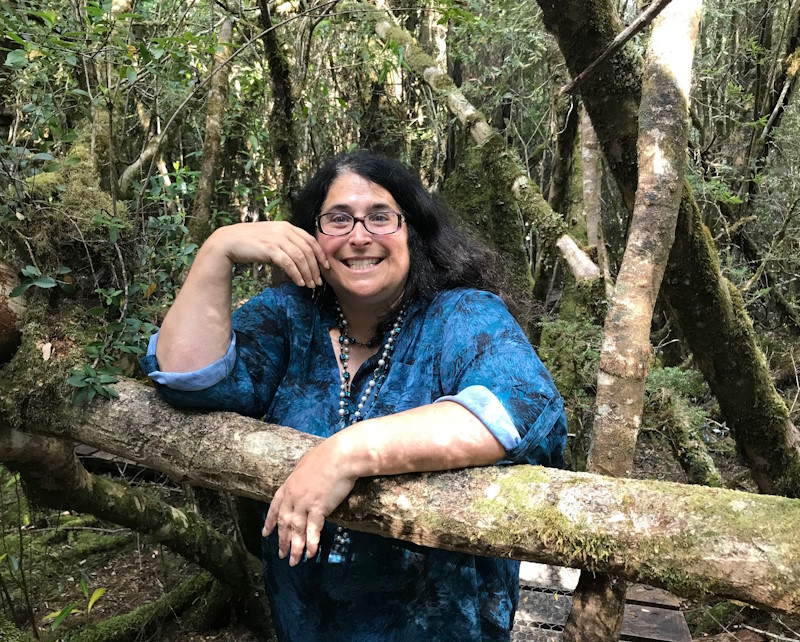Simone Cuff shares Dr Lisa-Ann Gershwin’s career story, including challenges and successes, for Disability History Month.

Imagine one of Australia’s foremost jellyfish specialists, a robust scientist with an encyclopaedic knowledge of jellyfish taxonomy and a deep understanding of their place in the marine environment. Now make them enthusiastic, unashamedly autistic and female. This is Lisa-Ann Gershwin. Dr Gershwin this year was named one of The Science Show’s Top 100 Australian Scientists, along with greats such as Sir Mark Oliphant FRS, Sir Douglas Mawson FRS, and Professor Frank Fenner FRS. Her road to science has not been a smooth one though.
As a child in California, Lisa-Ann had always surrounded herself with animals, including a keeping a sidewinder, a gopher, and a bat in her bedroom. Then, on a school trip to a local aquarium in 3rd grade she had her first glimpse of invertebrate life under the ocean, and Lisa was hooked. She knew what she wanted to be: a marine biologist.
As primary school became high school, Lisa-Ann’s undiagnosed autism meant she was noticed as different by some of the other students. As she told the ABC’s Richard Fidler “High school was a disaster for me. I was bullied very badly, my family was falling apart, and it was just a disaster. And so I disengaged from high school, I disengaged from learning... and I left school halfway through 10th grade.” Formally, she was a dropout.
But your label does not make you who you are, and withdrawing from the education system did not change the fact that she was smart. With a passion for ocean life.
After leaving school Lisa did a number of unrelated jobs, never losing her love of discovery. In her 20s, she attended a marine biology course at the local community college. On the last field trip of the course, poor weather prevented the boats from going out, so the students were given the option of going to an aquarium or going home. Lisa-Ann chose to go to the aquarium. To her delight, it was the Cabrillo Marine Aquarium, the same one that had sparked her interest back when she had last seen it as a small child.
It was still as wonderful as she had remembered. At one point, the class rounded a corner to find the jellyfish display in front of them. Lisa-Ann was mesmerised. They were so beautiful. They were alive, and yet floated in the seawater like clouds. She listened keenly to the presentation, then stayed back after the rest of the class had left, asking more questions. Once she had asked the aquarium keepers all they knew about the jellyfish, she had one last enthusiastic question for them - what did she have to do to become a volunteer there?
Four and a half years of volunteering at the aquarium was the launchpad for a degree at California State University to further discover marine biology. Despite thinking that she wouldn’t get a scholarship because “I’m a high school dropout… I’m not that kind of person”, she was awarded a prestigious Fulbright Scholarship to the University of Tasmania and the South Australian Museum to investigate jellyfish taxonomy. During her subsequent PhD she drove around the entire coast of Australia, describing 14 new species of life-threatening Irukandji jellyfish and investigating their biology.
She has since worked with a number of museums including as head of science at the Queen Victoria Museum and Art Gallery in Launceston, spent 7 years researching at the CSIRO laboratories in Australia, and is the director of the Australian Marine Stinger Advisory Services.
In each position, she has shared her enthusiasm for jellyfish and the marine environment, and striven to effect change. As well as her research, which has led to her identifying over 200 different jellyfish (and one dolphin), she has written three books, “Stung”, “Jellyfish: A Natural History”, and “Shapeshifters”, and presented twice with TedX. As part of her research she helped develop a tool for predicting jellyfish blooms, which can be signals of stressed ecosystems and indeed can take them over. Her advocating for the marine environment has included presenting evidence to the Tasmanian Parliament on the damage caused by salmon farming.
Lisa-Ann describes her neurodivergence as central to her science and who she is. While it has been a source of joy as she has been able to immerse herself in the details of jellyfish taxonomy and ecology, it has also come with difficulties. “I just have always felt like I'd parachuted down into medieval Japan and I didn't have a guidebook. I didn't have a translation program.” In addition, the rate of depression is around four times greater in autistic people than the general population, and in keeping with that Lisa has had ongoing battles with depression, including one severe bout that led to her becoming homeless for 18 months. It is typical of her approach to life that her experiences and those of the people around her “stoked a fire in my belly for justice” and after her recovery she stood for election to the Tasmanian parliament as an independent candidate on a platform of improving mental health and disability provision.
Twenty years after her first PhD, she is now completing a second PhD, this time on the role of scientists in environmental conflict.
“[My brain] has allowed me to live a life despite the fact that I’m different and because of the fact that I am different... I believe that my autism has allowed me to be a much better scientist than I ever could have been without it.”
This post has been written as part of the Reclaiming narratives: ScienceWrite blog series which highlights the lives and achievements of extraordinary scientists from minoritised groups.









